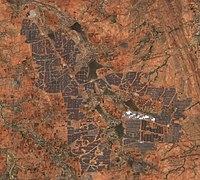
Photo from wikipedia
Abstract The impacts of increasing deployment of Renewable Energy Sources (RES) on existing energy infrastructure has been investigated in a microgrid, an energy system that, with its constraints, foreshadows the… Click to show full abstract
Abstract The impacts of increasing deployment of Renewable Energy Sources (RES) on existing energy infrastructure has been investigated in a microgrid, an energy system that, with its constraints, foreshadows the challenges of the evolving electricity network. The campus microgrid of the University of California, Irvine (UCI) is modeled, including an existing natural gas-fueled combined cycle power plant, electric chilling and thermal energy storage, and analyzing the microgrid response to additional Photovoltaic (PV) installations. Open area on the campus of UCI can accommodate a maximum of 15 MW of fixed PV installation, and up to 22 MW of ground-mounted 2-axis tracking PV systems, providing together 37 MW of peak renewable capacity. The microgrid response to renewable installed capacity has been evaluated for different renewable installed capacity scenarios, ranging from the current 4 MW of installed capacity up to 35 MW. The results of the UCI microgrid analysis show that the RES penetration in supplying of the campus electrical demand could increase to 19% with the installation of 35 MW of PV, but 58% of the renewable production would be temporally in excess of demand and would have to be stored or curtailed, showing that a large-scale electrical energy storage system is required. A minimum aggregated power capacity of 300 kW of Solid Oxide Electrolysis (SOE) systems (the power capacity increment) is considered in the microgrid. The aggregate capacity is sized to absorb at least 80% of the excess annual renewable power production for each renewable capacity scenario, implementing a dispatch strategy able to respond to excess solar power available in the microgrid. The dynamic dispatch results of the modular SOE systems show that for cases with a renewable installed capacity higher than 15 MW, there is large excess electricity and so a great potential for hydrogen production. Almost 550 tons per year of hydrogen were produced for 35 MW of renewable installed capacity. The feasibility of on-site hydrogen utilization such as in the local hydrogen fueling station for fuel cell electric vehicles and the direct injection of the produced hydrogen into the gas turbine fuel inlet to reduce the natural gas consumption have been analyzed.
Journal Title: Energy Conversion and Management
Year Published: 2020
Link to full text (if available)
Share on Social Media: Sign Up to like & get
recommendations!